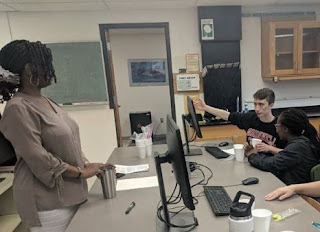 |
| Martin presenting his research at the 2019 KU Undergraduate Research Poster Session in July |
 |
| Martin working with Dr. Agusto |
The title of Martin's study is Effectiveness of Disease Control Measures in Pathosystems with Co-Infection and Vector Preference. He said, “I chose to model plant diseases because understanding how to control them is extremely significant for agriculture and for the conservation of biodiversity." He described his research as follows: "Most plant-vector-virus diseases found in nature are caused by the presence and interaction of multiple viruses in organisms. This interaction is called co-infection. The three main types of co-infection are helper-dependence, cross-protection, and synergism. Organisms such as aphids or other insects are called Vectors. Vectors can carry the diseases in these pathosystems, and they tend to prefer certain categories of host plants over others. In this study, we attempted to make a general compartmental disease model that incorporated co-infection, vector preference, and the transmission of disease to hosts. I tested three common disease control strategies that are utilized in agriculture: 1. increasing the planting of healthy plant hosts; 2. roguing (removal of diseased plant hosts); and 3. the use of pesticides. I hypothesized that using pesticides would be the most effective control measure, with the other two measures being less effective. I also did not think there would be significant differences when testing different types of co-infection or vector preference. I found that when Vectors preferred healthy hosts and all types of co-infection were considered, none of the control measures fully eliminated the disease. When Vectors did not prefer healthy hosts, applying pesticides was the most effective control. The control strategy of increasing the planting of healthy hosts was consistent across all considerations but rarely lowered disease incidence significantly. This was not expected. However, planting hosts with cross-protection present did lower disease occurrence. Roguing, on the other hand, completely eliminated the disease with the presence of helper-dependence and cross-protection, but was largely ineffective against pathosystems with synergism. Rouging’s effectiveness was highly variable depending on the type of co-infection present in the system, which was not expected. Overall, the use of pesticides tended to be the most effective control strategy for each situation.” Even though Martin's model found pesticides to be the most effective control measure, he warned, "applying this measure could prove dangerous and possibly lead to pesticide resistance."
 |
| Martin's poster illustrating his methods and results |
Martin is from the San Francisco Bay Area and is currently a sophomore at Grinnell College in Grinnell, IA. He is pursuing a double major in Mathematics and German. During the academic year, Martin is a calculus tutor for his college, and he serves as a German Lab Instructor teaching vocabulary, grammar, and culture to students enrolled in the Intermediate German course. Being a serious musician, Martin plays the violin, viola, and piano and is also a member of a String Quartet. When asked about his hobbies, Martin responded, “My biggest hobby is soccer, and I am a 'regular' in my college’s club soccer scene. I can also be found watching international soccer on my phone regularly.”
After earning his bachelor’s degree, Martin plans to attend graduate school and study “a quantitative discipline that utilizes my math skills in applied ways.” Once he completes his education, he will pursue a career as “a data scientist, using numbers and data to learn more about the world” around him.
Workforce Development, Education and Outreach funding for the KU MAPS Summer REU is provided by the Kansas NSF EPSCoR RII Track-1 Award OIA-1656006 titled: Microbiomes of Aquatic, Plant, and Soil Systems across Kansas. The grant's workforce development and educational objectives are designed to enhance STEM education in Kansas by supporting activities that will lead to an expanded STEM workforce or prepare a new generation for STEM careers in the areas of aquatic, plant and soil microbiome environments and ecological systems.
